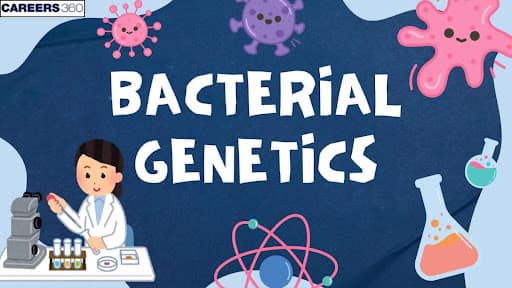Bacterial Genetics
Bacterial genetics is the branch that studies heredity in bacteria. It explains how bacteria pass on their genetic material and how bacteria adapt to their changing environment. Bacteria, a simple unicellular organism, serve as a model organism in genetics. These studies explain the genetic recombination in bacteria, focusing on bacterial conjugation, transformation, and transduction.
This Story also Contains
- Bacterial Conjugation in Microbiology and Biology
- Transformation in Bacteria
- Transduction in Bacteria
- Genetic Recombination in Bacteria and its Applications
- Difference between Conjugation and Transduction
- MCQs on Bacterial Genetics

Bacteria reproduce rapidly and can exchange genetic material through various processes. This allows them to evolve quickly and survive in different environments. Understanding bacterial genetics has led to developments in biotechnology, medicine and agriculture. It also plays a crucial role in producing useful products like insulin and vaccines.
Bacterial Conjugation in Microbiology and Biology
Bacterial conjugation is a key concept in the molecular basis of inheritance, as it involves the transfer of genetic material between bacteria through direct cell-to-cell contact, which is facilitated by a structure called the pilus. In this process, DNA transfer occurs from a donor cell to a recipient cell and involves plasmids, which are small, circular DNA molecules. This process is a type of conjugation gene transfer, vital in bacterial genetics for sharing traits such as antibiotic resistance.
Types of Bacterial Conjugation
There are different types of bacterial conjugation based on the plasmid involved:
F+ to F- Conjugation: This involves the transfer of an F plasmid from an F+ (fertility plasmid-containing) bacterium to an F- bacterium.
Hfr Conjugation: High-frequency recombination (Hfr) involves the transfer of chromosomal genes from an Hfr donor to a recipient cell, along with part of the plasmid DNA. These types of bacterial conjugation are key to understanding gene transfer mechanisms in microbiology and biology.
Transformation in Bacteria
Transformation in bacteria is the process through which bacteria acquire new genetic material from their environments. Genetic transformation involves the process of taking in free DNA fragments, which, on integration into the bacterial chromosome may lead to bacterial recombination.
While undergoing transformation, a competent bacterium takes up free DNA from its surroundings. This can subsequently get into its genome through recombination. More importantly, the process can be visualized by understanding the transformation diagram and its mechanism, which is quite often covered in transformation notes.
Transduction in Bacteria
Transduction in bacteria occurs when bacteriophages transfer genetic material between bacterial cells. There are two main types of transduction:
Generalized Transduction: Any bacterial gene can be transferred by a lytic bacteriophage during its life cycle.
Specialized Transduction: A lysogenic phage incorporates specific bacterial genes as it excises from the host genome.
Genetic Recombination in Bacteria and its Applications
These processes, including conjugation, transformation, and transduction, are essential in bacterial genetics. It results in bacterial recombination and creates genetic diversity among bacterial populations. These contribute to genetic recombination, a key topic for understanding bacterial adaptation in different environments.
Applications in Bacterial Genetics and Conjugation Biology
Understanding bacterial conjugation and the steps involved in transformation and transduction is critical for applications in microbiology. In biotechnology, these processes enable genetic engineering, such as the creation of recombinant bacteria, which is a common topic in bacterial genetics. The study of conjugation biology also provides insights into how bacterial genetics evolve and adapt over time, aiding in the development of treatments for bacterial infections.
Difference between Conjugation and Transduction
Conjugation involves the direct transfer of genetic material from donor to recipient through cell-to-cell contact using a pilus. Whereas transduction is the process where a bacteriophage (virus) transfers DNA from one bacterium to another. The table given below shows the major difference between conjugation and transduction in bacteria:
Conjugation | Transduction |
Conjugation is the process in which genetic material is transferred between two bacterial cells by the formation of a pilus. | Transduction is the process in which genetic material is transferred between two bacterial cells with the help of temperate phage or bacteriophage. |
Conjugation was discovered by Joshua Lederberg and Tatum. | Transduction was discovered by Norton Zinder and Joshua Lederberg. |
Horizontally the DNA is transferred. | Vertically DNA is transferred |
The host cell is not killed after the end of the process. | In specialized transduction, the host cell is killed after the end of the process. |
The whole genetic material of bacteria is transferred in the form of a plasmid. | Fragments of the DNA are transferred. |
MCQs on Bacterial Genetics
Q1. Transfer of genetic material from the donor to recipient bacterium through cell contact is termed as
Transduction
Recombination
Conjugation
Transformation
Correct Answer: 3) Conjugation
Explanation:
Conjugation is a process of horizontal gene transfer in bacteria where genetic material (usually a plasmid) is transferred from a donor to a recipient cell through direct physical contact, typically via a sex pilus. This process was first discovered in E. coli by Joshua Lederberg and Edward Tatum. It is one of the key methods of genetic variation in bacteria.
Hence, the correct answer is option 3) Conjugation.
Q2. Common vegetative reproduction in bacteria is by
Conjugation
Budding
Oidia
Binary fission
Correct answer: 4) Binary fission
Explanation:
Binary fission is the most common form of asexual reproduction in bacteria. In this process, a single bacterial cell duplicates its DNA and divides into two identical daughter cells. It is a rapid and efficient way for bacteria to multiply under favorable conditions.
Hence, the correct answer is option 4) Binary fission.
Also Read:
Frequently Asked Questions (FAQs)
Bacterial genetics is the study of heredity and variation in bacteria, including how they transfer and express genes.
Joshua Lederberg is known as the father of bacterial genetics for his work on genetic recombination in bacteria.
It helps in understanding antibiotic resistance, genetic engineering, and the development of vaccines and biotechnology.
Examples include E. coli (used in experiments), Streptococcus, and Salmonella.
Bacteria need DNA to store genetic information, control cell functions, and reproduce.